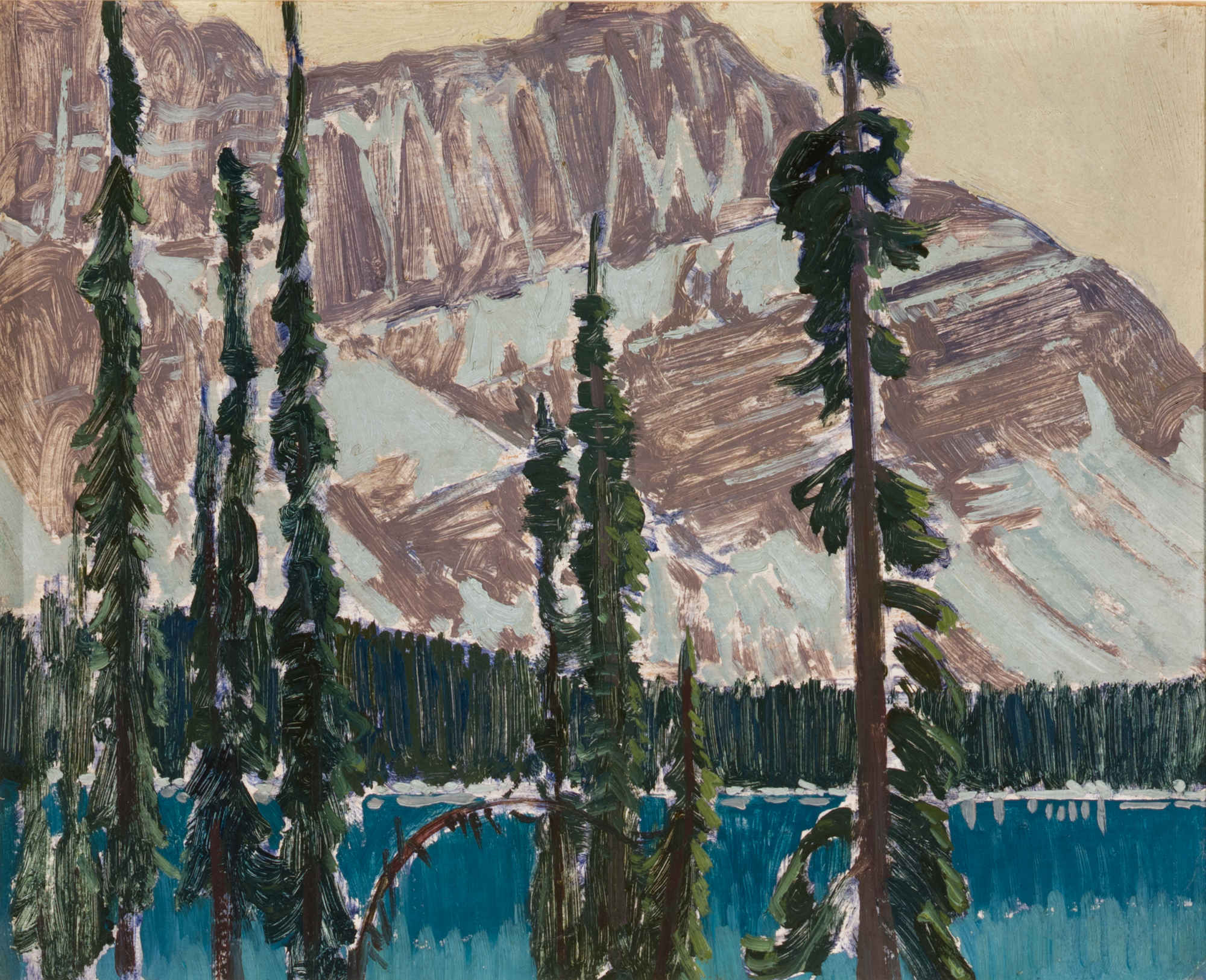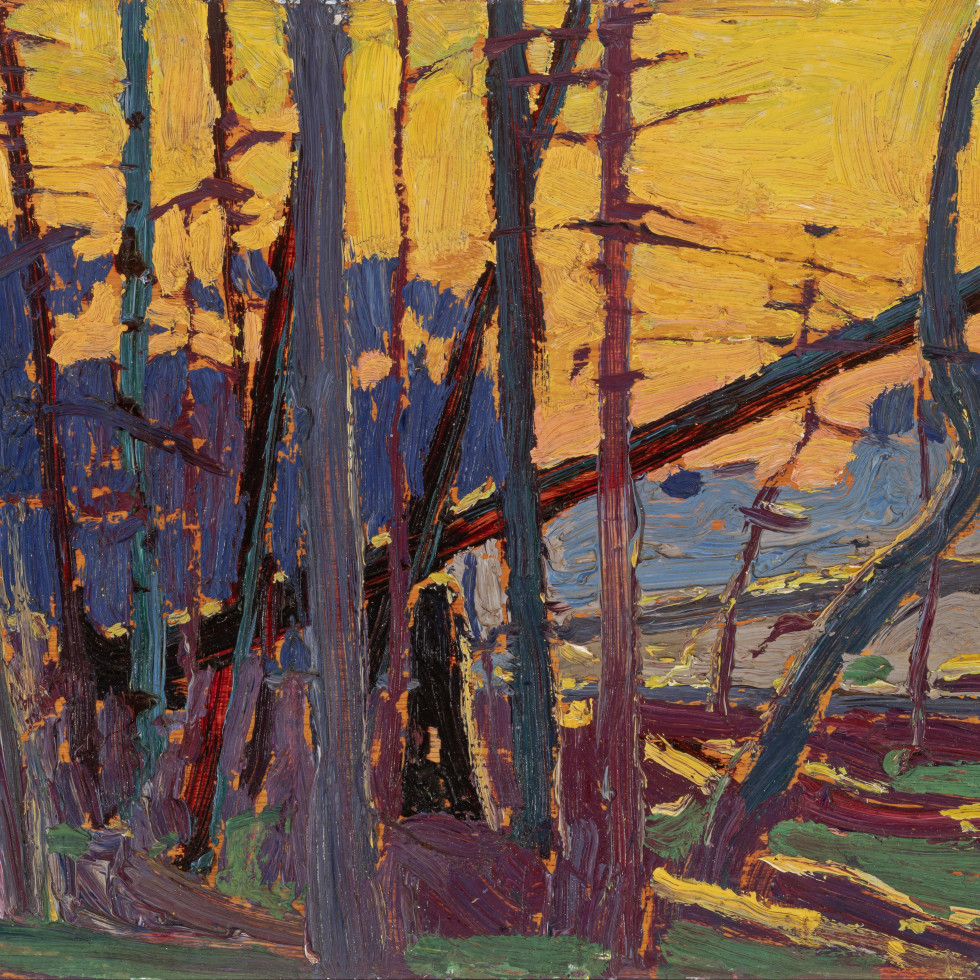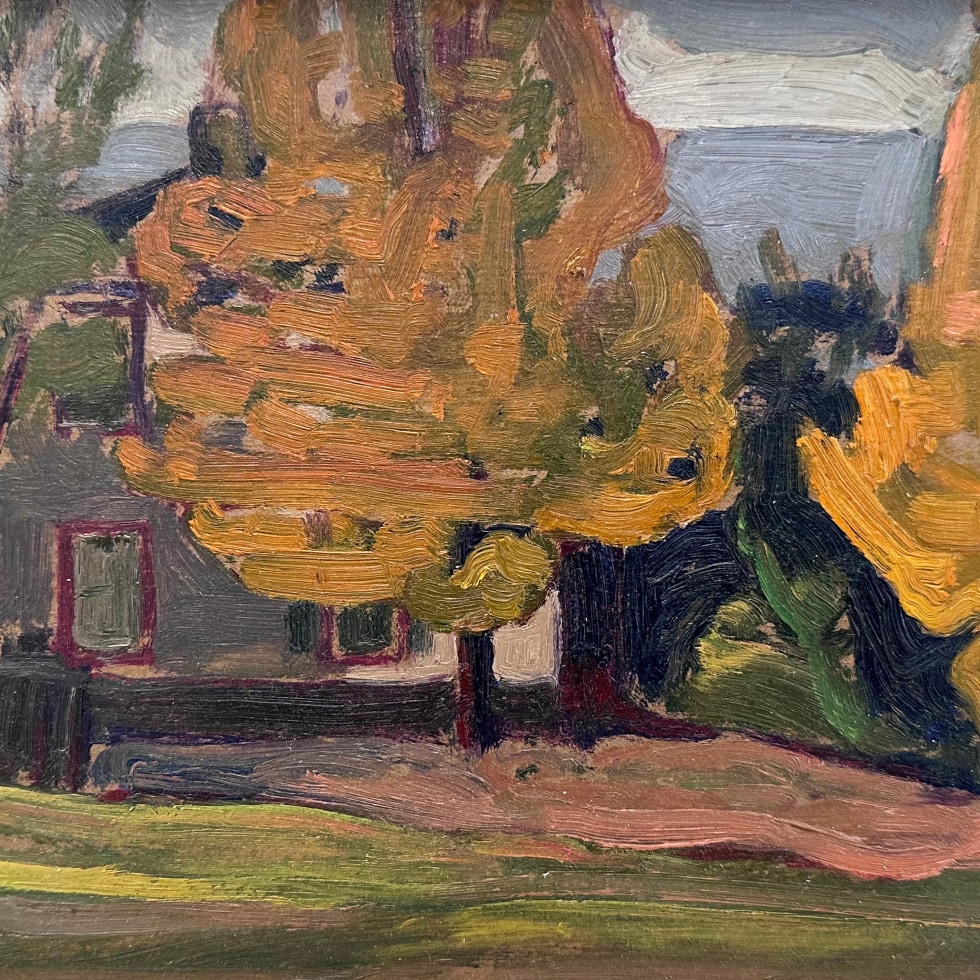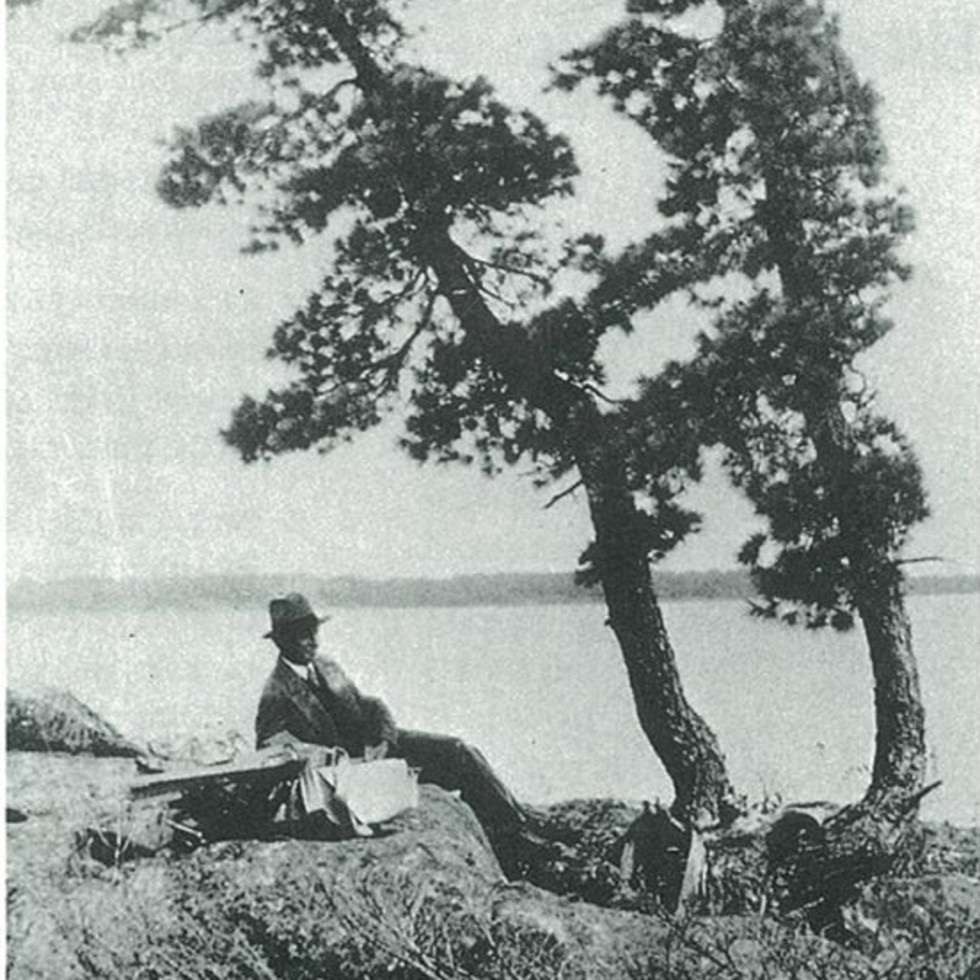Notable Sales
Lake O'Hara and Mt. Schäffer, 1926 or 1927
21.6 x 26.7 cm
Inscriptions
titled, labeled and inscribed, ‘L. O’Hara & Mt. Schaffer’ (verso, upper centre); impressed stamp, JM (monogram) / 1932 (verso, upper right)Provenance
Estate of the artist.
Galerie Walter Klinkhoff Inc., Montreal;
Acquired from the above by Mitzi and Mel Dobrin.
-Lisa Christensen
Constrained by the demands of teaching at Toronto’s Ontario College of Art, MacDonald wasn’t able to join his fellow members of the Group of Seven on their sketching expeditions after 1920. However in 1924 he travelled alone to Lake O’Hara in Yoho Park in the Rocky Mountains. He would return to Lake O’Hara late summer every year for the next five years. The resultant canvases, painted in Toronto when time permitted, show the effects of his many distractions. With a few exceptions, they are over-designed and dead in colour, while the sketches retain the vivacity of the immediate contact with his subjects.
MacDonald’s letters and journals of his western trips are replete with daily accounts of weather, the difficulties of sketching due to changing light effects, and the problems of finding good painting sites protected from rain and snow. Lisa Christensen has given us the most informative account of MacDonald’s paintings of the Rockies in her book The Lake O’Hara Art of J.E.H. MacDonald and Hiker’s Guide (Calgary: Fifth House Publishers, 2003). With Christensen’s map and her first hand experience of the many trails and painting sites, the reader is able to share the joys, hazards and labours of painting in mountain terrain. MacDonald painted Lake O’Hara and Mount Schäffer from the shore of Lake O’Hara looking towards Mount Schäffer, situated on the lower slopes of Mount Odoray between Lakes McArthur and O’Hara. Named after Mary T.S. Schäffer who located Maligne Lake in 1908 from a map drawn by the Stoney native Sampson Beaver (Christensen, A Hiker’s Guide to Art of the Canadian Rockies, 1996), Mount Schäffer is perceived through a screen of tall, spindly firs. While foreground trees were a common device in paintings by Tom Thomson and the Group of Seven, from Thomson’s The Jack Pine to Lawren Harris’ North Shore, Lake Superior (both National Gallery of Canada), in almost all their canvases and in MacDonald’s Rockies sketches, the trees grow out of a foreground shore, a stepping stone into the picture. Unusually, here MacDonald has excluded the foreground shore. The viewpoint is high up creating a more spacious effect that is enhanced by the cool palette of mauve-browns, greyed whites contrasting with the clear blues and greens. The texture of the rock face is effectively interpreted through the thin application of paint letting the wood show through in one of MacDonald’s most restrained and evocative mountain sketches.
Interestingly MacDonald reinterpreted this sketch in a gouache dated 1927 (sold Sotheby’s, Toronto, 31 May 1990, lot 226) that was possibly an illustration for a proposed booklet on Yoho Park. In 1927 MacDonald provided drawings for a Canadian National Railway booklet on Jasper Park but Yoho Park was Canadian Pacific territory and the CPR’s brochure, Resorts in the Canadian Pacific Rockies only included one MacDonald, a reproduction of his oil sketch Morning, Lake O’Hara.
Charles C. Hill
In 1924, the first time that J.E.H. MacDonald travelled the almost 4000 mile journey from Toronto to Lake O’Hara in Yoho National Park, the CPR gave him a private car. From it, he watched Canada flying by outside his window. In his small journal, he recorded everything from his observations on settlements the train passed through to his daily budget. He wrote poetry, made lists, and always described the landscape with his insightful painter’s eye. After reaching Wapta Station, he took the last leg of his journey to Lake O’Hara on an uncooperative pack horse. The horse, apparently, sized-up MacDonald instantly, by looking “…beneath a drowsy lid / Deep where my timid city spirit hid” and inspired the poem My High Horse, from which those words are taken. Despite this, MacDonald instantly fell under the spell of Lake O’Hara’s beauty, so much so that he sought out its scenery above that of all others, returning each year until 1930, when work and failing health prevented it.
Over those years, he painted many vistas of the region, from his favoured locations on the Opabin Plateau to more remote spots such as nearby Ross Lake on the Great Divide trail in the valley below O’Hara. Here, in this delicate work, MacDonald has painted a classic view. Lake O’Hara and Mount Schäffer is set from a spot near the Seven Veils Falls on what is now the Adeline Link Memorial Trail – also known as the Lake Shore Trail. While an easy walk around a tranquil lake today, this wide path was not created until well after MacDonald’s death. His habit – then born from necessity - was to row across Lake O’Hara and scramble around, using the edges of stream beds, scree and boulder slopes, as well as horse and other animal trails, to access higher elevations. He would pick his way upslope, laden with all his gear to gain a vantage point, or follow a goat path to access an overlook, where he could set up his paint box, erect his umbrella, make a seat from his neatly folded coat, and sit to work. For the vista in this work, he must have climbed up from where he would have moored the rowboat, away from the rocky, sloping shore that drops directly into the lake. There was no other option. Such are the practicalities of painting out-of-doors, and MacDonald revelled in them. Anything the mountains presented, from weather to wildlife to uncooperative pack horses, he embraced. Smoke from forest fires blowing in from the west created “beautiful mist effects” and “delicate mouse-grey colour.” These comments, taken from his 1930 journal (in the holdings of the Library and Archives of Canada), seem to echo the colour of this work. He also noted the ever-changing conditions presented challenges, such as “snow reflections [that] were beautiful,” while others were more daunting, “transient and ... beyond me.”
In addition to being a charming work, touched with delicate brushstrokes and capturing the colour of Lake O’Hara under a clouded or smoke-tinged sky exactly, this sketch recalls a canvas that MacDonald painted in his studio after a Lake O’Hara trip. The arced tree in the middle of the stand of firs in Lake O’Hara and Mount Schäffer is reminiscent of the arced tree in Rain in the Mountains, (Art Gallery of Hamilton). It forms a lyrical addition to the otherwise uniform band of trees. The two works are set from locations not far apart on the lake’s shore.
Each new work that comes to light from MacDonald’s Lake O’Hara period is an exciting and informative mark on the art historical map of that region, and Lake O’Hara and Mount Schäffer marks another spot. These works speak of his deep attachment to the region, best expressed in his poem of the same name, written in March of 1927. A lament of sorts, written in late winter in Toronto, it is filled with a yearning desire to be in the mountains, sitting on his ulster, his billy-can stove bubbling with hot tea, writing poems and sketching: “I would away / Away to O’Hara / By the peaks lifted / holier that Tara / Shading the prairie / Through the cleft mountains / I would be kneeling / By her green fountains”
Lisa Christensen

















